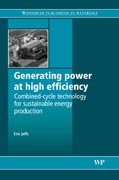
Generating power at high efficiency: combined cycle technology for sustainable energy production
Jeffs, E.
A secure energy supply is essential to our way of life. However, diminishing fossil fuel reserves, the slow development of renewable energy generation and concerns about climate change have all focused attention on maximising the efficiency of conventional power stations. Using examples drawn from plants around the world, this important book reviews key developments in combined cycle technology in helping to ensure sustainable energy production. After an introductory chapter setting the scene, Chapter 2 traces the early development of the combined cycle in Europe and North America to achieve higher efficiency of power generation. It describes the evolution of the concept of two gas turbines driving a small steam turbine as suitable gas turbines appeared with high exhaust temperatures and operating at synchronous speeds. Chapter 3 complements Chapter 2 with examples of early combined cycle plants. Chapter 4 reviews the development of gas turbines from early heavy frame designs and the application ofaero-derivative engines. It covers such important technical features as low emission combustors and static-converter starting systems. The chapter considers the various cooling arrangements which prompted significant design changes to hold down emission levels as pressure ratios and combustion temperatures rose, including the evolution of annular combustors and use of steam cooling of static parts and of bled air for turbine blade cooling. Chapter 5 discusses improvements in steam generator design. It describes drum types and once-through concepts of heat recovery boilers, the advantages of each type, and the effecton the performance of the steam cycle of larger gas turbines developing higher pressures and temperatures. The chapter also reviews how the combined cycle has to respond to the changing organization of electricity supply systems to meet the requirements for base load, mid-load and peak-time operations and frequency control. Mainly in Europe and Asia, the largest gas turbines are configured into a single-shaft block with the gas turbine and steam turbine driving at opposite ends of a common generator. Chapter 6 discusses their development and its impact on design and performance. In contrast Chapter 7 looks at the more specialised option of repowering steam turbines. Where suitable, it has created higher efficiency and lower emissions with the replacement of coal or oil-fired boilers by a gas turbine and heat recovery boiler. Chapter 8 describes the development of combined heat and power technology from its origins in small schemes applied to a single industrial site to larger schemes serving industrial estates. For as long as there have been gas turbines the question has been asked if one could be produced that could burn coal. Chapter 9 reviews threetechnologies have been developed in practice. The first is the closed cycle gas turbine with a coal-fired combustor. The second is the PFBC gas turbine with a coal-fired, pressurized fluidized bed as the combustion chamber. The chapter then considers coal gasification schemes integrated with the combined cycle. The final chapter looks at some of the issues which are shaping the energy system of the future and discusses how the combined cycle can evolve to meet the different needs of a future market driven by a greater contribution of base-loaded nuclear and renewable energy sources, mainly wind and solar power. Based on a wealth of experience, and drawing on a range of practical examples, Generating power at high efficiency will be a valuable reference for all those wishing to improve the efficiency of the power industry.
- ISBN: 978-1-84569-433-3
- Editorial: Woodhead
- Encuadernacion: Cartoné
- Páginas: 216
- Fecha Publicación: 01/04/2008
- Nº Volúmenes: 1
- Idioma: Inglés
